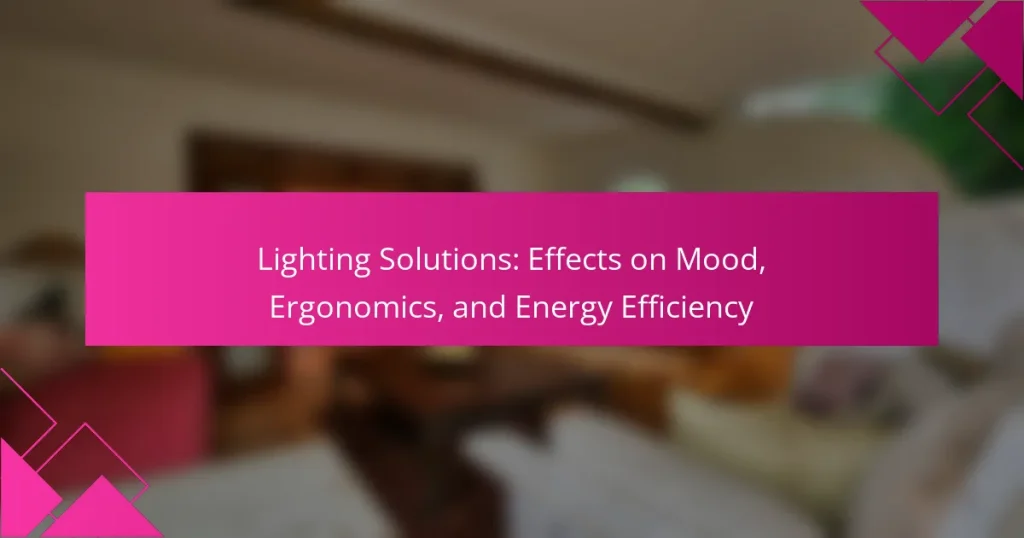Lighting solutions refer to systems designed to provide illumination through natural and artificial light sources, enhancing visibility and aesthetics in various environments. These solutions significantly impact mood, ergonomics, and energy efficiency. Effective lighting can improve emotional responses and mental states, with bright light boosting alertness and dim light promoting relaxation. Ergonomically designed lighting reduces eye strain and fatigue, enhancing productivity. Additionally, advanced technologies like LED and smart lighting systems increase energy efficiency, lowering energy consumption and greenhouse gas emissions. Overall, the article explores the multifaceted benefits of lighting solutions in creating functional and appealing spaces.
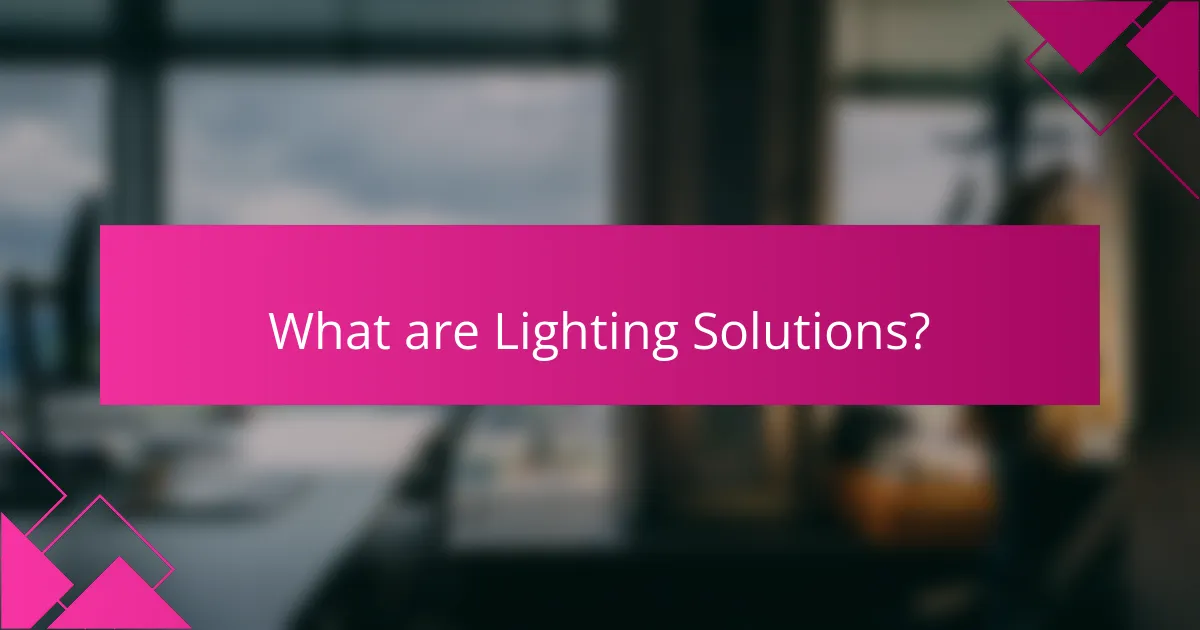
What are Lighting Solutions?
Lighting solutions are systems designed to provide illumination in various environments. They can include natural and artificial light sources. These solutions enhance visibility and contribute to the aesthetics of spaces. Effective lighting solutions improve mood and productivity. They can also increase energy efficiency through the use of LED technology. Studies show that proper lighting can reduce eye strain and fatigue. For instance, well-lit environments are linked to higher employee satisfaction. Overall, lighting solutions play a crucial role in both functionality and ambiance.
How do Lighting Solutions impact our daily lives?
Lighting solutions significantly impact our daily lives by influencing mood, productivity, and energy consumption. Proper lighting enhances our emotional well-being and can reduce feelings of stress and anxiety. Studies show that natural light exposure increases serotonin levels, promoting a positive mood.
In work environments, adequate lighting improves focus and reduces eye strain. Research indicates that well-lit spaces can boost productivity by up to 20%. Additionally, energy-efficient lighting solutions, such as LED bulbs, reduce electricity usage, leading to lower utility bills and a smaller carbon footprint.
Overall, effective lighting solutions contribute to healthier living and working conditions, making them essential in our daily routines.
What are the different types of Lighting Solutions available?
The different types of lighting solutions available include ambient, task, accent, and decorative lighting. Ambient lighting provides overall illumination for a space. Task lighting focuses on specific areas for activities like reading or cooking. Accent lighting highlights particular objects or features, enhancing aesthetics. Decorative lighting serves primarily an ornamental purpose. Each type serves unique functions and contributes to mood and energy efficiency. For instance, LED lights are energy-efficient and long-lasting, making them a popular choice across all types.
How do Lighting Solutions vary in design and function?
Lighting solutions vary significantly in design and function. Different lighting solutions include ambient, task, and accent lighting. Ambient lighting provides general illumination for a space. Task lighting focuses on specific areas for activities like reading or cooking. Accent lighting highlights particular features or objects. The design of lighting solutions can range from modern to traditional styles. Materials used can include metal, glass, or plastic. Color temperature affects the mood, with warmer tones promoting relaxation and cooler tones enhancing alertness. Energy efficiency varies, with LED options consuming less power than incandescent bulbs. According to the U.S. Department of Energy, LED lighting can use up to 75% less energy.
Why is understanding the effects of Lighting Solutions important?
Understanding the effects of Lighting Solutions is crucial for enhancing well-being and productivity. Proper lighting can significantly influence mood and cognitive function. Studies show that natural light exposure can improve alertness and reduce fatigue. Additionally, effective lighting design can enhance ergonomics in workspaces. This leads to better focus and reduced eye strain. Energy-efficient lighting solutions also contribute to sustainability. They lower energy consumption and reduce operational costs. Understanding these effects allows for informed decisions in lighting design and implementation.
How do Lighting Solutions influence mood and emotional well-being?
Lighting solutions significantly influence mood and emotional well-being. Bright lighting can enhance alertness and energy levels. Conversely, dim lighting often promotes relaxation and calmness. Natural light exposure is linked to improved mood and reduced symptoms of depression. Studies show that environments with appropriate lighting can lead to increased productivity and satisfaction. For example, a study published in the Journal of Environmental Psychology found that well-lit spaces positively affect emotional states. Specific light colors also play a role; blue light is known to enhance focus, while warmer tones create a cozy atmosphere. Therefore, the choice of lighting directly impacts emotional responses and overall mental health.
What role do Lighting Solutions play in enhancing productivity and focus?
Lighting solutions significantly enhance productivity and focus by providing optimal illumination conditions. Proper lighting reduces eye strain and fatigue, which are common barriers to concentration. Studies indicate that natural light exposure can improve mood and alertness, leading to better work performance. A report from the American Society of Interior Designers found that well-lit environments can increase productivity by up to 20%. Additionally, adjustable lighting allows individuals to tailor their workspaces to their specific tasks, further enhancing focus. Bright, cool lighting has been shown to stimulate cognitive function, while softer, warmer tones can create a calming atmosphere conducive to deep work. Overall, effective lighting solutions are crucial for creating environments that foster productivity and concentration.
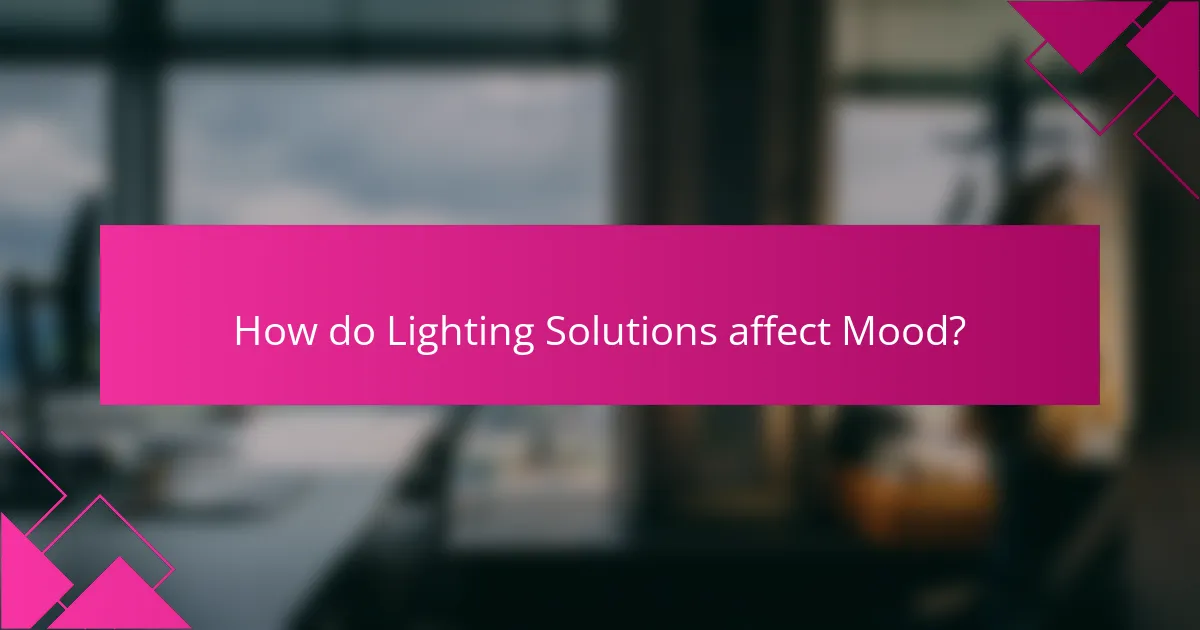
How do Lighting Solutions affect Mood?
Lighting solutions significantly affect mood by influencing emotional responses and mental states. Bright lighting can enhance alertness and energy levels. Conversely, dim lighting often promotes relaxation and calmness. Color temperature also plays a crucial role; warm light can create a cozy atmosphere, while cool light may increase focus. Studies show that exposure to natural light improves mood and reduces feelings of depression. For instance, research published in the Journal of Environmental Psychology indicates that well-lit environments positively correlate with increased happiness and productivity. Therefore, the choice of lighting solutions is vital for creating desired emotional environments.
What types of lighting are best for improving mood?
Natural light and bright white artificial light are best for improving mood. Natural light exposure increases serotonin levels, which enhances mood and energy. Bright white artificial light mimics daylight and can reduce symptoms of Seasonal Affective Disorder (SAD). Studies show that environments with adequate lighting can boost productivity and overall well-being. A study published in the Journal of Environmental Psychology found that bright lighting positively affects mood and cognitive performance. Using full-spectrum bulbs can replicate natural light indoors. Soft, warm lighting can create a cozy atmosphere but may not be as effective for mood enhancement.
How does natural light compare to artificial light in mood enhancement?
Natural light significantly enhances mood more effectively than artificial light. Exposure to natural light increases serotonin levels, which improves mood and promotes feelings of well-being. Studies show that individuals exposed to natural light report lower levels of stress and anxiety. In contrast, artificial light, particularly fluorescent lighting, can lead to increased fatigue and irritability. Research published in the Journal of Environmental Psychology indicates that natural light exposure is linked to improved cognitive function and emotional health. Additionally, natural light helps regulate circadian rhythms, further contributing to mood stability. Overall, the benefits of natural light in mood enhancement are well-documented and supported by scientific evidence.
What color temperatures are most effective for mood regulation?
Color temperatures between 2700K and 3000K are most effective for mood regulation. These warmer tones create a cozy and inviting atmosphere. Research indicates that warmer lighting can help reduce stress and promote relaxation. Conversely, cooler temperatures around 5000K to 6500K can enhance alertness and concentration. Studies show that exposure to cooler light can improve cognitive performance. Therefore, a balance of warm and cool color temperatures can effectively regulate mood throughout the day.
How can Lighting Solutions be utilized in different environments?
Lighting solutions can be utilized in various environments to enhance functionality and atmosphere. In residential settings, warm lighting creates a cozy ambiance, promoting relaxation. In office spaces, bright, cool lighting improves focus and productivity. Retail environments benefit from strategic lighting that highlights products and creates an inviting atmosphere. Outdoor lighting enhances safety and security while adding aesthetic value to landscapes. In healthcare facilities, appropriate lighting can aid in patient recovery and comfort. Studies indicate that different light spectrums can influence mood and energy levels, supporting the need for tailored lighting solutions in diverse settings.
What are the best practices for lighting in workspaces?
The best practices for lighting in workspaces include using a combination of natural and artificial light. Natural light enhances mood and productivity. Position workstations near windows to maximize daylight exposure. Use adjustable task lighting for specific tasks to reduce eye strain. Ensure ambient lighting is uniform to avoid harsh shadows. Incorporate dimmable lights to allow for flexibility based on the time of day. Select energy-efficient LED bulbs to reduce energy consumption. Research shows that proper lighting can improve employee satisfaction and performance. For instance, a study by the Heschong Mahone Group found that natural light can increase productivity by up to 15%.
How should lighting be designed in residential spaces for optimal mood?
Lighting in residential spaces should be designed to enhance mood through a combination of brightness, color temperature, and placement. Soft, warm lighting creates a cozy atmosphere. Bright, cool lighting can energize and increase alertness. Layering different light sources, such as ambient, task, and accent lighting, allows for flexibility in mood setting. Dimmers can adjust brightness according to time of day and activity. Natural light exposure is also essential for well-being. Research shows that well-designed lighting can improve mood and productivity. For example, a study by the Lighting Research Center indicates that natural light can reduce stress and enhance overall happiness.
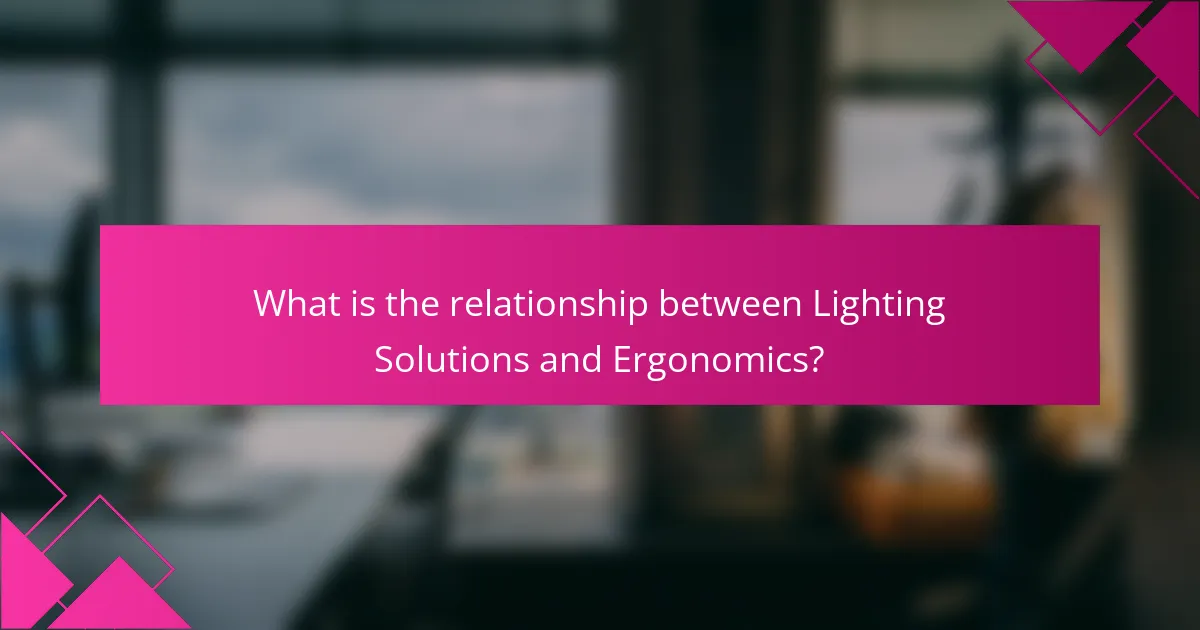
What is the relationship between Lighting Solutions and Ergonomics?
Lighting solutions directly impact ergonomics by influencing visual comfort and reducing fatigue. Proper lighting enhances visibility and minimizes glare, which can lead to improved posture and reduced strain on the eyes. Studies show that well-designed lighting can enhance productivity and comfort in work environments. For instance, a report by the American Society of Interior Designers states that appropriate lighting can reduce eye strain by up to 30%. This relationship underscores the importance of integrating effective lighting solutions into ergonomic design.
How does lighting design impact physical comfort in workspaces?
Lighting design significantly impacts physical comfort in workspaces. Proper lighting enhances visibility and reduces eye strain. Bright, well-distributed light can boost alertness and concentration. Conversely, inadequate lighting may lead to fatigue and discomfort. Studies show that natural light improves mood and productivity. For example, a study by the Heschong Mahone Group found that daylighting in schools improved student performance. Additionally, adjustable lighting allows individuals to tailor their environment to personal preferences. This customization fosters a sense of control, contributing to overall comfort. Therefore, effective lighting design is crucial for optimizing physical comfort in work settings.
What are the ergonomic benefits of proper lighting?
Proper lighting enhances ergonomic benefits by reducing eye strain and improving concentration. Adequate light levels minimize glare and shadows, which can lead to discomfort and fatigue. Studies show that well-lit environments can boost productivity by as much as 20%. Proper lighting also helps maintain a natural circadian rhythm, promoting better sleep and overall well-being. This is crucial in workspaces where extended hours are common. Ergonomically designed lighting can lead to fewer headaches and reduced musculoskeletal issues. A well-lit workspace encourages proper posture and reduces unnecessary movements, enhancing comfort.
How can poor lighting lead to ergonomic issues?
Poor lighting can lead to ergonomic issues by causing visual strain and discomfort. Insufficient light levels make it difficult to see clearly, leading to awkward postures. Workers may lean closer to their tasks, increasing the risk of musculoskeletal disorders. Additionally, glare from bright lights can cause eye fatigue, which distracts from proper posture. A study from the American Optometric Association found that poor lighting contributes to headaches and fatigue. These factors collectively create an environment that promotes ergonomic problems. Proper lighting is essential for maintaining a comfortable and healthy workspace.
What considerations should be made for ergonomic lighting solutions?
Considerations for ergonomic lighting solutions include brightness levels, color temperature, and placement. Brightness should be adjustable to suit different tasks and preferences. A color temperature of around 4000K to 5000K is ideal for promoting alertness. Additionally, lighting should minimize glare and shadows to reduce eye strain. Placement of lights should ensure even distribution across workspaces. Using task lighting can help focus on specific areas without overwhelming brightness. Finally, incorporating natural light can enhance mood and productivity. Studies show that appropriate lighting can significantly improve comfort and performance in work environments.
How can task lighting improve ergonomics in various settings?
Task lighting improves ergonomics by providing focused illumination for specific tasks. This targeted light reduces eye strain, allowing users to see details clearly. Proper task lighting minimizes the need for awkward body positions. It encourages a more natural posture during activities such as reading or typing. Studies show that well-lit workspaces can enhance productivity and comfort. A 2021 report by the International Journal of Occupational Safety and Ergonomics highlights that appropriate lighting can decrease fatigue. Additionally, adjustable task lighting allows users to customize brightness levels. This adaptability further supports individual ergonomic needs across different settings.
What are the guidelines for selecting ergonomic lighting fixtures?
Select ergonomic lighting fixtures by considering several key guidelines. First, prioritize adjustable lighting options to accommodate various tasks and preferences. Second, ensure the color temperature is appropriate, typically between 3000K to 5000K for optimal comfort. Third, choose fixtures that minimize glare to reduce eye strain. Fourth, utilize dimmable lights to allow for brightness adjustments based on time of day and activity. Fifth, consider the placement of fixtures to provide even illumination across workspaces. Lastly, select energy-efficient lighting solutions to enhance sustainability and reduce operational costs. These guidelines support better visual comfort and overall well-being in work environments.
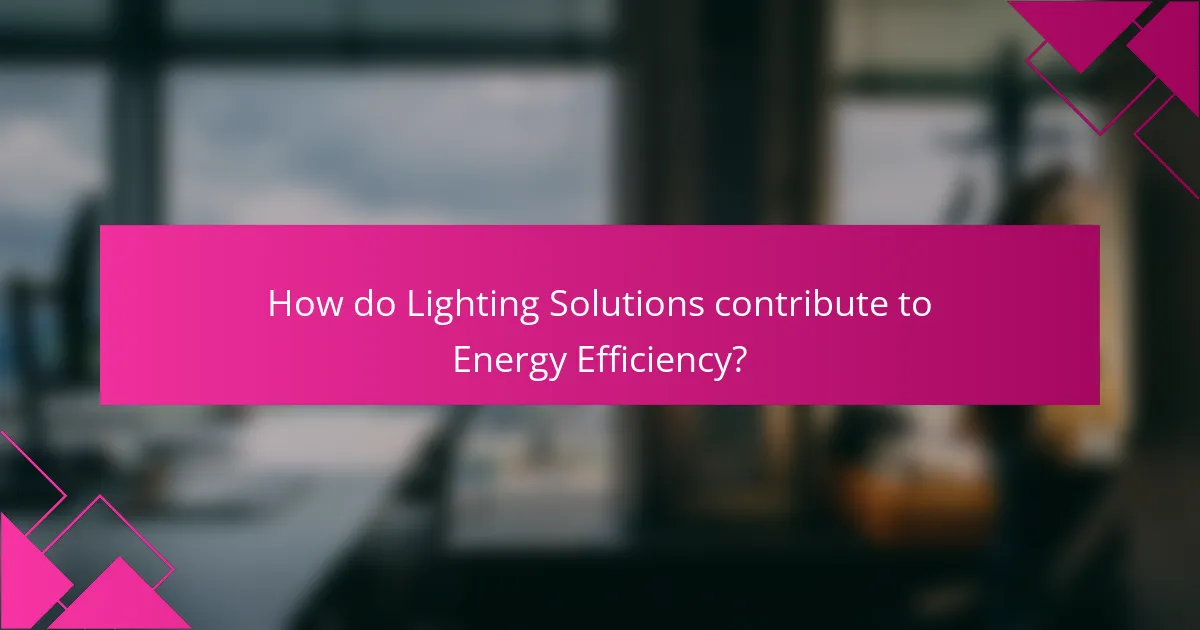
How do Lighting Solutions contribute to Energy Efficiency?
Lighting solutions enhance energy efficiency by utilizing advanced technologies like LED and smart lighting systems. These technologies consume significantly less energy compared to traditional incandescent bulbs. For instance, LED lights use about 75% less energy and last 25 times longer. Smart lighting systems optimize energy use through automation and remote control features. They can adjust brightness based on occupancy or natural light availability. This reduces unnecessary energy consumption. Additionally, energy-efficient lighting solutions lower greenhouse gas emissions, contributing to environmental sustainability. According to the U.S. Department of Energy, widespread adoption of energy-efficient lighting could save over $30 billion annually in energy costs.
What are the energy-efficient options available in lighting solutions?
Energy-efficient options available in lighting solutions include LED bulbs, CFLs, and solar-powered lights. LED bulbs consume up to 75% less energy than incandescent bulbs. CFLs use about 70% less energy than traditional lighting. Solar-powered lights harness sunlight, reducing reliance on electricity. These options not only lower energy bills but also have longer lifespans. For example, LED bulbs can last up to 25,000 hours. This longevity results in fewer replacements and less waste. Overall, these lighting solutions contribute to significant energy savings and environmental benefits.
How do LED lights compare to traditional lighting in energy consumption?
LED lights consume significantly less energy than traditional lighting options, such as incandescent and fluorescent bulbs. LED lights use approximately 75% less energy than incandescent bulbs. They also have a longer lifespan, lasting up to 25,000 hours compared to the 1,000 hours of incandescent bulbs. This energy efficiency translates to lower electricity bills and reduced carbon emissions. According to the U.S. Department of Energy, widespread use of LED lighting could save over $30 billion annually in energy costs by 2027. Thus, LED lights are a more energy-efficient choice compared to traditional lighting.
What are the long-term cost benefits of energy-efficient lighting?
Energy-efficient lighting provides significant long-term cost benefits. These lighting solutions reduce energy consumption by up to 75% compared to traditional bulbs. This leads to lower electricity bills over time. Additionally, energy-efficient bulbs have a longer lifespan, lasting up to 25,000 hours or more. This reduces the frequency and cost of replacements.
According to the U.S. Department of Energy, switching to energy-efficient lighting can save an average household about $225 in energy costs over the lifetime of the bulbs. Furthermore, energy-efficient lighting often qualifies for rebates or incentives, further decreasing initial costs. Overall, the combination of reduced energy use, longevity, and potential rebates results in substantial savings.
How can businesses and homeowners implement energy-efficient lighting?
Businesses and homeowners can implement energy-efficient lighting by switching to LED bulbs. LED bulbs use up to 80% less energy than traditional incandescent bulbs. They also have a longer lifespan, lasting up to 25,000 hours. This reduces the frequency of replacements and waste.
Installing motion sensors and dimmers can further enhance energy efficiency. Motion sensors automatically turn lights off when a room is unoccupied. Dimmers allow users to adjust brightness levels based on need, saving energy.
Additionally, businesses and homeowners should consider using natural light where possible. Daylighting reduces reliance on artificial lighting during daylight hours.
Regular maintenance of lighting fixtures ensures optimal performance. Dust and dirt can diminish light output, leading to increased energy consumption.
According to the U.S. Department of Energy, energy-efficient lighting can save businesses and homeowners significant costs on electricity bills.
What steps can be taken to transition to energy-efficient lighting solutions?
To transition to energy-efficient lighting solutions, begin by assessing current lighting systems. Identify the types of bulbs in use and their wattage. Next, research energy-efficient options such as LED or CFL bulbs. These alternatives consume significantly less energy. Replace existing bulbs with energy-efficient ones gradually. Implement smart lighting controls to optimize usage and reduce waste. Consider the layout of lighting to ensure maximum efficiency. Regularly evaluate energy consumption to track improvements. According to the U.S. Department of Energy, switching to LED lighting can save up to 75% on energy costs.
What are the common misconceptions about energy-efficient lighting?
One common misconception about energy-efficient lighting is that it provides inadequate brightness. Many people believe that energy-efficient bulbs, like CFLs and LEDs, are dim compared to traditional incandescent bulbs. However, energy-efficient lighting can produce the same or even greater lumens per watt. For instance, a 10-watt LED bulb can produce around 800 lumens, comparable to a 60-watt incandescent bulb.
Another misconception is that energy-efficient lighting is too expensive. While the initial cost may be higher, energy-efficient bulbs last significantly longer and reduce electricity bills. Research shows that LED bulbs can last up to 25,000 hours, while incandescent bulbs typically last only about 1,000 hours.
Additionally, some think that energy-efficient lighting emits harsh or cold light. In reality, energy-efficient options come in various color temperatures, including warm white tones. This allows consumers to choose lighting that suits their preferences and needs.
Finally, there is a belief that all energy-efficient lighting contains harmful chemicals. While some fluorescent bulbs contain small amounts of mercury, many energy-efficient options, like LEDs, do not contain hazardous materials. This makes them a safer choice for both homes and the environment.
What are some practical tips for optimizing Lighting Solutions?
To optimize lighting solutions, focus on three key areas: intensity, color temperature, and placement. Adjusting the intensity of lighting can significantly impact mood and productivity. Studies show that brighter environments can enhance alertness, while softer lighting promotes relaxation.
Color temperature also plays a crucial role. Warmer tones (2700K-3000K) are ideal for relaxation spaces, while cooler tones (4000K-5000K) boost focus and energy in work areas.
Proper placement of lighting fixtures ensures even distribution and minimizes shadows. Task lighting should be directed towards work areas, while ambient lighting should fill the entire space.
Utilizing dimmers and smart controls allows for flexibility in adjusting lighting based on activity and time of day. Energy-efficient LED bulbs not only reduce energy consumption but also have a longer lifespan, making them a cost-effective choice.
Implementing these strategies can enhance mood, improve ergonomics, and increase energy efficiency in any environment.
Lighting solutions are systems that provide illumination through natural and artificial sources, significantly impacting mood, productivity, and energy efficiency. This article explores the various types of lighting solutions, including ambient, task, and accent lighting, and their effects on emotional well-being and cognitive function. It highlights the importance of proper lighting design in enhancing ergonomics and reducing eye strain, as well as the benefits of energy-efficient options like LED technology. Additionally, the article addresses how lighting solutions can be optimized for different environments to improve overall comfort and sustainability.
